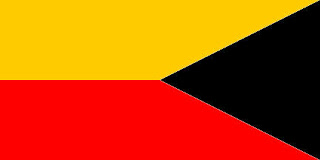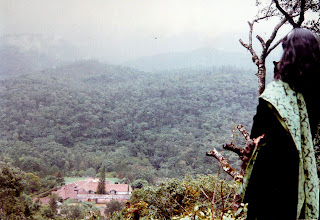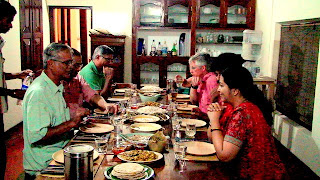Bhor, the erstwhile princely state
Flag of Bhor
Yesterday, I had a telephonic talk with HH Raja Shrimant Yogeshrao Chimnajirao Pandit Pant Sachiv, Raja of Bhor, the erstwhile princely state near Pune. We got introduced and I spoke to him in Pune while travelling in a car in Dubai. He is the maternal uncle of Amita, the wife of my colleague and friend, Dilip Gejji, stationed in Auckland.
Dilip is a Maharashtra Brahmin by birth and very well informed on various matters. While we were driving out for lunch, I told him that the then Raja of Bhor, Shankar Rav Chimanji Pant Sachiv was honoured by the King Emperor George V, during the Delhi Durbar of 1911 by giving him the honour of 11 personal guns salutes. Very amused, Dilip told me that he shall contact Mama which paved way for our talk.
The Raja was extremely polite and kind while talking. When I mentioned that I have read about the honours conferred upon his great grandfather by the King Emperor in 1911, he was very happy. He told of his visit to London along with his father in 1937 as guests of the British Royalty when they stayed at the Buckingham Palace. He further informed of their 300 year old palace near Pune and welcomed me with family there during a visit to India. We also shared some talk on Bhor of the past and about the life in Pune in the present.
Padma Lokur, Princess of Bhor, and mother-in-law of Dilip is a prolific writer. She remembers how when her brother was born, 'many married women came to the palace with large vessels full of milk which was poured on the palace steps’. This was on the tenth day of birth of a child in the royal household.
Bhor was one of the Deccan and Kolhapur princely States of British India now part of Maharashtra. A feudatory of Satara State, Bhor was bestowed on Shankarji Narayan, Pant Sachiv, in 1697, by Raja Ram of Satara, for his services. Of the six Satara Jagirs or feudatories which became tributaries to the British Government on the lapse of the Satara territory in 1849, four, viz: Bhor, Phaltan, Aundh and Jath were under the supervision of the Collector of Satara as Political Agent.
Situated among the higher peaks of the Western Ghats, the state covered an area of 2357 square kilometres, and had a population of 137,268 in 1901. Its Hindu rulers, of the Deshastha Brahmin caste, used the title "Pant Sachiv" and were entitled to a hereditary 9-gun salute.
The last Ruler of Bhor was Raja Shrimant Sir Raghunathrao Shankarrao Babasaheb Pandit Pantsachiv. The town of Bhor, once the capital of the princely state, is located about 40 kilometres south of Pune, adjacent to Bhatghar dam.

A ½-anna red Pant Sachiv Shankarrao postal stamp.
Bhor and some history:
Bhor begins from the north-west corner of Satara on the north of the Mahadev hills. With a breadth varying from thirty-five miles in the south to fifteen miles in the north, Bhor stretches north-west over the rough Sahyadri lands in south-west Poona. It has an estimated area of about 1491 square miles, a population of 145,876, and in AD 1883 gross revenue of Rs. 5 Lakhs.
In 1882-83 it had three civil and seven criminal courts. Besides thirty horsemen in the head-quarter guard who aid as mounted police, the police were 184 strong. There is no municipality, but a committee of five officers supervise sanitary arrangements. The local funds collections amounted to Rs. 31,000, which are said to have been spent on local objects; 1045 patients were treated at the Bhor dispensary and 2267 persons were vaccinated. There are twenty-seven schools with 923 pupils.
History
In 1697 Rajaram, the son of Shivaji, appointed Shankarji Narayan Pant Sachiv for his able services.
The Pant Sachiv was one of the titles given to his eight ministers by Shivaji at the time of his crowning in 1674. The eight titles were the peshwa or prime minister, pant amatya or councillor, pant sachiv or minister, mantri or general councillor, sumant or foreign minister, nyayadhish or judge, and panditrav or the learned. In 1698 a ninth title of pant pratinidhi or viceroy, ranking higher than the other eight, was created by Rajaram.
He was given an estate or jagir and rent-free lands. In 1707, Shankarji died at Ambevadi and was succeeded by his son Naro. On his death in March 1737, Naro was succeeded by his nephew Chimnaji who had three sons Sadashivrav, Anandrav, and Raghunathrav. In 1757, on the death of Chimnaji, his eldest son Sadashivrav became Pant Sachiv. In 1787, on his death Sadashivrav was succeeded by his youngest brother Raghunathrav. On Raghunathrav's death in 1791, his son Shankarrav became Pant Sachiv. He had no male issue and adopted Chimnaji who succeeded him in 1798. Till their downfall in 1818, Chimnaji continued in the service of the Peshwas. On his death in 1827, Chimnaji was succeeded by his adopted son Raghunathrav; for this adoption a nazarana or present of Rs. 40,000 was paid to the Raja of Satara. In 1836 Raghunathrav, being without legitimate male issue, adopted Chimnaji who succeeded him in 1839. On the 12th of February 1871, on his death Chimnaji was succeeded by his son Shankarrav. During the chief's minority a karbhari or manager was appointed by the British Government to look after his affairs. In 1874 at the age of twenty-one, Shankarrav assumed the charge of his state. The Pant Sachiv ranks as first class sardar. His yearly tribute was Rs. 5235 to the British Government, nominally on account of pilkhana or elephant stables.
Uprisings, 1857
No outbreak occurred at Satara or Bhor during the uprising, but evidence was discovered of a widespread conspiracy only a week before the date fixed for the rising. A Ramoshi named Nana Raghu Chavhan, who about AD 1831 had received Rs. 10,000 from Government for the arrest of the notorious Ramoshi bandit Umaji Naik, told a dismissed agent of the Pant Sachiv that a conspiracy was on foot in Satara. The Pant Sachiv's agent told Mr. Rose, the District Magistrate on the 10th June 1857. Inquiry showed that armed Marathas had gathered at Bagarvadi a village near Bhor, the Pant Sachiv's capital that they had started for Satara, and had arranged for Ramoshi and others to follow them. As there was a large Ramoshi population near Bagarvadi, thirty of the Southern Maratha Irregular Horse were sent under Lieutenant Kerr, accompanied by the First Assistant Commissioner Lieutenant Sandford, to intercept them. The party marched forty-five miles in sixteen hours over difficult rugged ground, but were seen by some of the Marathas who returned from Satara and the greater number of the men escaped to the hills. Thirteen Marathas were seized, but of the thirteen, only one was a man of consequence. All confessed that they had come together for the purpose of attacking the station at Satara. In consequence of this intelligence the magistrate asked for a detachment of European troops from Poona which arrived towards the end of the month. On the day after the intelligence was received from Bhor, a Rajput messenger on the establishment of the Satara Judge's court was arrested in the lines of the 22nd Regiment native Infantry at Satara, endeavouring to corrupt a Subedar and through him all the Indian men of the regiment. The magistrate Mr. Rose was empowered to try him by special commission and he was executed on the 20th of June. On the scaffold he harangued the people present telling them that the English had less hold on the country than when they set foot in it, and urging them as the sons of Hindus and Musalmans not to remain quiet. Ref: http://www.maharashtra.gov.in/english/gazetteer/SATARA/
Dubai, 27th February 2008.




Comments
A few months ago I had gone on a visit to Shivthar Ghal, the natural cave at the foot of the Varandha Ghat where Ramadas Swami wrote his Das Bodh. On my way back to Pune, I made a short detour through the town of Bhor to look at the Wada of the Pant Sachiv. Bhor is a small town and the Wada is in the heart of the old part. I only saw it from the outside. It now looks quite delapilated and hemmed in by similar old houses.
Just outside Bhor is a bridge on the river Neera, constructed around 1930. The commemmorative stone on it gives the name of the then Ruler of Bhor and his wife. It was completely plastered over by handbills announcing the program of a poitical party and I had to tear it off to read the inscription!
You would of course know the Bhatghar Dam and its predecessor Whting Dam built by the British on Neera.
With the collapse of the Maratha power,many of the old forts of the Marathas, like Rajgad and Raigad, closely bound with Shivaji's activities, went in the nominal area of the Bhor Sansthan. I have visited all of them and extensively read about them. My impression is that the Rulers of Bhor neglected the upkeep of these places as they were more interested in staying on the right side of the British than preserving the memory of those because whom they would eventually rise to the dignity of 'Raja'!
Arvind Kolhatkar, Toronto, May 18, 2008.
kind regards,
Murali, Dubai
Thanks and regards
Thanks for your mail. I was delighted to visit your site www.dadinani.com which I found quite interesting. I could only read excerpts and it was indeed indication of some wonderful memoirs.
I have referred your mail to my friend Dilip Gejji, who shall be in touch with you with the needed references and assistance. Do let me know of the follow-ups.
Kind regards,
Bhor held a special place in his heart.
he was born in the Bavadekar family of bhor, who were closely associated with the kings of bhor and according to my father, my grandfather vinayakrao held a position equivalent to the prime minister of the state, and was also the district and sessions judge.
My father had fond memories of his childhood and youth spent in Bhor.
Eventually, he settled in Belgaum, where I was born and brought up. Though Belgaum has also a deep significance for our family, with my fathers grandfather, Gangadharrao Deshpande being a freedom fighter of this area, I have always felt the void of not knowing my fathers family history.
This was one of the posts I turned to, in a vain attempt to replace my father's fond memories with the world wide web.
I am very moved by reading your comments. I convey you my deepest condolences on the sad demise of your beloved father. I realize how much he meant to you, as I think of my own father who is aged 89 and back in India at my ancestral home.
I read the details about your father, grandfather and great grandfather with great interest. All of them, I could easily understand, belonged to a world of larger value systems as compared to the present one.
Just as your father always retained fond memories of Bhor, my father Rama Varma keeps similar memories of the erstwhile princely state of Cochin and the royal family of Kodungallur, a principality in it. He had his high school days, staying at the royal household of Kodungallur staying with the senior Rajah there.
I bow in reverence to the memory of your venerable father and pray for his departed soul.
With kindest regards,
Murali
The information about Bhor Dynasty was a good reading. I write this as the Bhorapgad or sudhagad (new name in free India) where the goddess Bhoraidevi is located was once Kuldaivat of Bhor Dynasty. My Great Grand father was also related to Bhor Dynasty. I am keen to know if any references can be had from the current generation e.g. HH Padma Lokur. Is it possible for you to help me.
With regards,
Uday Bhagwat
Kind regards,
i am naresh nigade stays in pune we belong to shirval near bhor we were given tamrapat by king of bhor but it is lost now can i please get any information now i am not interested in property but i have to search my native village becuase i am not sure about that shirval is our native village
I wrote article about Raghunathrao Shankarrao Pant Sachiv and Shankarrao Chimnajirao Pant Sachiv. I'm still working on the article. Can you help me.
I wrote article about Raghunathrao Shankarrao Pant Sachiv and Shankarrao Chimnajirao Pant Sachiv on Wikipedia. I'm still working on the article. Can you help me.
I wrote article about Raghunathrao Shankarrao Pant Sachiv and Shankarrao Chimnajirao Pant Sachiv on Wikipedia. I'm still working on the article. Can you help me.
I wrote article about Raghunathrao Shankarrao Pant Sachiv and Shankarrao Chimnajirao Pant Sachiv on Wikipedia. I'm still working on the article. Can you help me.
Can you find out Death Date and Month of Raghunathrao Shankarrao Pant Sachiv (11th Raja Of Bhor). It would be helpful for Wikipedia article.
Thank you